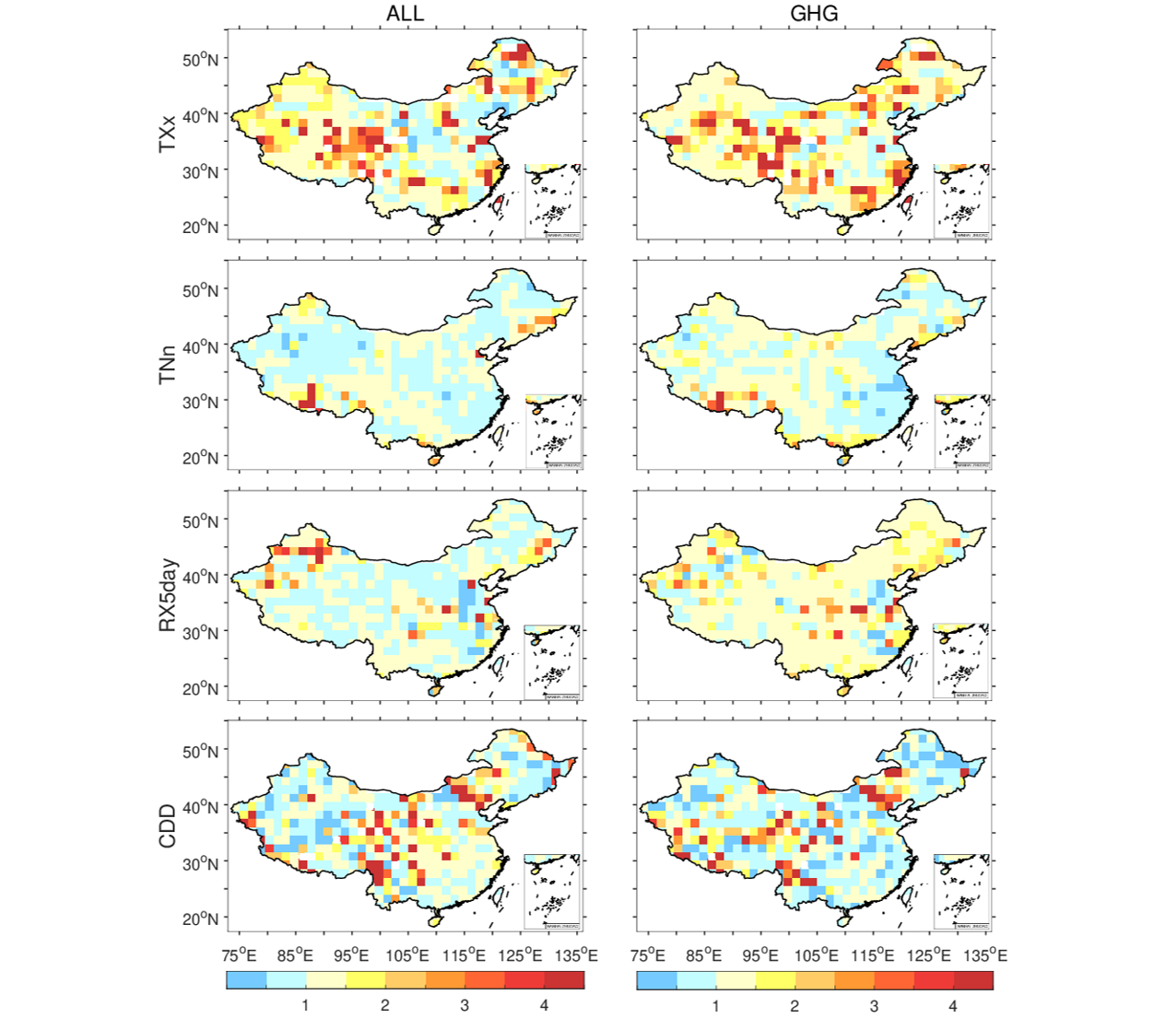联系我们
竺可桢-南森国际研究中心
邮 箱:nzc_iap@mail.iap.ac.cn
邮 编:100029
地 址:北京市朝阳区德胜门外祁家豁子华严里40号 竺南中心

科研进展
Research Progress人类活动已显著影响中国极端气候变化
Anthropogenic influence has increased climate extreme occurrence over China
[2021-04-28]
【中文介绍】
越来越多的研究证据表明,人类活动引起的全球增暖已对全球和区域尺度的极端气候变化产生显著影响,尤其是极端高温事件。最近,也有研究指出在中国极端气候变化中也检测到了人类活动的痕迹;而且随着未来增暖的加剧,人类活动对极端气候变化的影响也在加强,这必将进一步恶化人类生存空间、阻碍社会和谐发展。因此,科学认识人类活动影响对于公众和政府都具有重要的现实意义,可为国家应对气候变化措施的制定提供科学支撑。但目前,人类活动对中国极端气候变化到底存在多大影响尚不清楚。
研究以日最高温极大值(TXx)、最低温极小值(TNn)、连续五天最大降水量(RX5day)和连续最大无雨日(CDD)为极端气候指标开展分析。观测事实指出,1961-2014年中国大部分区域高温均呈现显著增加趋势,其增加趋势导致中国约79%的地区高温发生频次和强度均显著增加,尤其是青藏高原东部地区,高温发生概率增加约4倍;整个中国区域平均高温发生概率增加约2.6倍。中国约有62%的区域极端降水发生频次也显著增加,尤其是西北、东北和青藏高原部分区域,发生概率几乎翻倍。而对于低温和连续无雨日,中国大部分区域呈现减少趋势。
CMIP6多模式集合结果能够合理再现中国区域这些极端气候指标的变化趋势。进一步利用CMIP6计划下不同强迫试验结果的归因研究(图1)指出,人类活动引起的温室气体排放增加已使得中国超过75%的区域发生极端高温事件的概率增加,其中至少有20%的区域其增加幅度超过了2倍;对于极端降水事件,人类活动已使得中国有超过56%的区域其发生概率显著增加。对于低温和连续无雨日,人类活动主要表现为负的贡献。未来人类活动排放的持续增加将会进一步加剧极端气候变化(图2)。在SSP5-8.5情景下,多模式集合预估指出,到了21世纪末(2081-2100年)中国区域平均的极端高温发生概率相比当代气候(1995-2014年)将增加约10倍,且从2080年左右开始,中国有80%的区域每年都会遭遇极端高温事件的影响;到了21世纪末中国区域极端降水事件发生概率相比当代气候几乎翻倍。
【英文介绍】
There is overwhelming evidence that anthropogenic activity has exerted a great influence on climate extremes, especially on heat events at continental to global scales. Recently, increasing evidence has also identified the anthropogenic influence on climate extremes over China. Further warming in the future will increase the anthropogenic influence on the climate extreme changes across China, which will deteriorate living spaces and hamper social development. Recognition of anthropogenic influence on such extreme events is thus urgent for the public and governments, which can help to establish public awareness of climate change and drive policy decisions for climate adaptation. However, to what degree anthropogenic influence is responsible for the climate extreme events remains an open issue.
Our attribution analyses based on different forcing simulations of CMIP6 models indicate that humans have increased probabilities of historical hot and wet extremes, including in more than 75% and 56% of the areas in China, respectively. Particularly for the hottest day, the probability has increased by more than two times in over 20% of the area, while the probability of historical clod events decreases over most of China. Increasing emissions in the future are likely to cause substantial and widespread additional increases, including more than tenfold for the hottest day and twofold for the extreme wet events by the end of this century. For example, the observed hottest day would occur for each year over 80% of China from 2080, while the observed coldest night would never occur, and the driest events would markedly decrease by the end of this century. Therefore, it is now urgent for governments and the public to properly adopt effective strategies to mitigate anthropogenic influence on climate change in the future.
【关键图表】

【引用格式】
Chen, H. P., and J. Q. Sun, 2021: Anthropogenic influence has increased climate extreme occurrence over China. Science Bulletin, 66, 749-752.